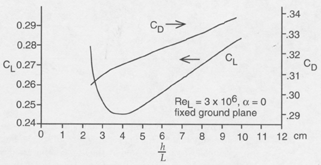This is a tricky issue because it is a balancing act. Without proper testing, I can't imagine any of us offering more than an intuitive suggestion.
My intuitive suggestion is to lower the ride height until ~6 inches of clearance exists between the road and frame, fair everything in sight as smoothly and thoughtfully as possible, and install stiffer springs that keep the car stable at an AOA (angle of attack) of 0 degrees.
The only thing I remember having read on the subject is this
online chapter that deals with race car aerodynamics. Here is the paragraph in question with its respective graph:
Quote:
|
Originally Posted by Race Car Aerodynamics - Joseph Katz
The effect of ground proximity was shown to have a strong influence on the aerodynamic coefficients of generic bodies. For enclosed-wheel vehicles, with reasonably clean underbody flow, drag and lift usually decreases with decreasing ground clearance, as shown in Fig. 6.18. The increase in the downforce can be attributed to the higher speeds under the car, with decreased ground clearance. The drag reduction in automobile shapes with major rear flow separations is partially a result of this faster airstream emerging from under the vehicle, which reduces the size of the rear flow separation.
Another effect that causes this trend is the reduction in the frontal exposed area of the wheels (as they slide into the body), which decreases drag with the reduced ground clearance. In regard to lift, the interesting observation is that the trend (that less ground clearance equals less drag and less lift) is reversed at a certain small distance. This is a result of the viscous effects (thick boundary layer) of the too-small ground clearance blocking the flow between the road and the vehicle underpanel. Thus, in this case of very small ground clearance the flow resembles the case of the semi-ellipsoid and not that of the ellipsoid. In Fig. 6.18 the critical distance for the lift reversal is close to 3.5 cm, but for full-scale race cars with smooth underbody, moving on the track, this distance can be as small as 0-5 cm.
|
Fig. 6.18 - Cd vs. Ground Clearance
 Lift and drag coefficient increments as a function of ground clearance (based on 1/5-scale wind tunnel test and model with smooth underbody and fixed ground plane).
Lift and drag coefficient increments as a function of ground clearance (based on 1/5-scale wind tunnel test and model with smooth underbody and fixed ground plane).
I do believe decreased ground clearance will eventually have a detrimental affect on overall drag, but I have no idea at what point. All modern aerodynamic cars, from Shell Ecomarathons to car prototypes, have gone either way. I think experimentation is the only true answer.
- LostCause